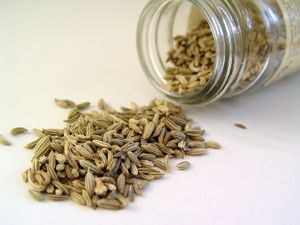Note: This is a project under development. The articles on this wiki are just being initiated and broadly incomplete. You can Help creating new pages.
Difference between revisions of "Foeniculum vulgare - Misreya"
| Line 1: | Line 1: | ||
[[File:Fennel seed.jpg|thumb|right|''Misreya'', ''Fennel '']] | [[File:Fennel seed.jpg|thumb|right|''Misreya'', ''Fennel '']] | ||
| + | '''Misreya''' or '''Fennel''' (Foeniculum vulgare) is a flowering plant species in the carrot family.<ref name="int"/> It is a hardy, perennial herb with yellow flowers and feathery leaves. It is indigenous to the shores of the Mediterranean but has become widely naturalized in many parts of the world, especially on dry soils near the sea-coast and on riverbanks. It grows on dry soils near the sea-coast and on riverbanks. | ||
| − | + | == Uses == | |
| − | |||
It is a highly aromatic and flavorful herb with culinary and medicinal uses and, along with the similar-tasting anise, is one of the primary ingredients of absinthe. Florence fennel or finocchio is a selection with a swollen, bulb-like stem base that is used as a vegetable. | It is a highly aromatic and flavorful herb with culinary and medicinal uses and, along with the similar-tasting anise, is one of the primary ingredients of absinthe. Florence fennel or finocchio is a selection with a swollen, bulb-like stem base that is used as a vegetable. | ||
| Line 9: | Line 9: | ||
Fennel is used as a food plant by the larvae of some Lepidoptera species including the mouse moth and the anise swallowtail. | Fennel is used as a food plant by the larvae of some Lepidoptera species including the mouse moth and the anise swallowtail. | ||
Fennel leaves are used in some parts of India as leafy green vegetables either by themselves or mixed with other vegetables, cooked to be served and consumed as part of a meal. In Syria and Lebanon, the young leaves are used to make a special kind of egg omelette (along with onions and flour) called ijjeh. | Fennel leaves are used in some parts of India as leafy green vegetables either by themselves or mixed with other vegetables, cooked to be served and consumed as part of a meal. In Syria and Lebanon, the young leaves are used to make a special kind of egg omelette (along with onions and flour) called ijjeh. | ||
| + | |||
| + | == References == | ||
| + | |||
| + | <references> | ||
| + | <ref name="int">[https://plants.usda.gov/java/ClassificationServlet?source=profile&symbol=FOENI&display=31 "Classification for Kingdom Plantae Down to Genus Foeniculum Mill."]</ref> | ||
| + | </references> | ||
| + | |||
| + | == Externa Links == | ||
| + | |||
| + | *[https://en.wikipedia.org/wiki/Fennel Fennel-Wikipedia] | ||
[[Category:Herbs]] | [[Category:Herbs]] | ||
Revision as of 10:11, 3 January 2017
Misreya or Fennel (Foeniculum vulgare) is a flowering plant species in the carrot family.[1] It is a hardy, perennial herb with yellow flowers and feathery leaves. It is indigenous to the shores of the Mediterranean but has become widely naturalized in many parts of the world, especially on dry soils near the sea-coast and on riverbanks. It grows on dry soils near the sea-coast and on riverbanks.
Uses
It is a highly aromatic and flavorful herb with culinary and medicinal uses and, along with the similar-tasting anise, is one of the primary ingredients of absinthe. Florence fennel or finocchio is a selection with a swollen, bulb-like stem base that is used as a vegetable.
Fennel is used as a food plant by the larvae of some Lepidoptera species including the mouse moth and the anise swallowtail. Fennel leaves are used in some parts of India as leafy green vegetables either by themselves or mixed with other vegetables, cooked to be served and consumed as part of a meal. In Syria and Lebanon, the young leaves are used to make a special kind of egg omelette (along with onions and flour) called ijjeh.
